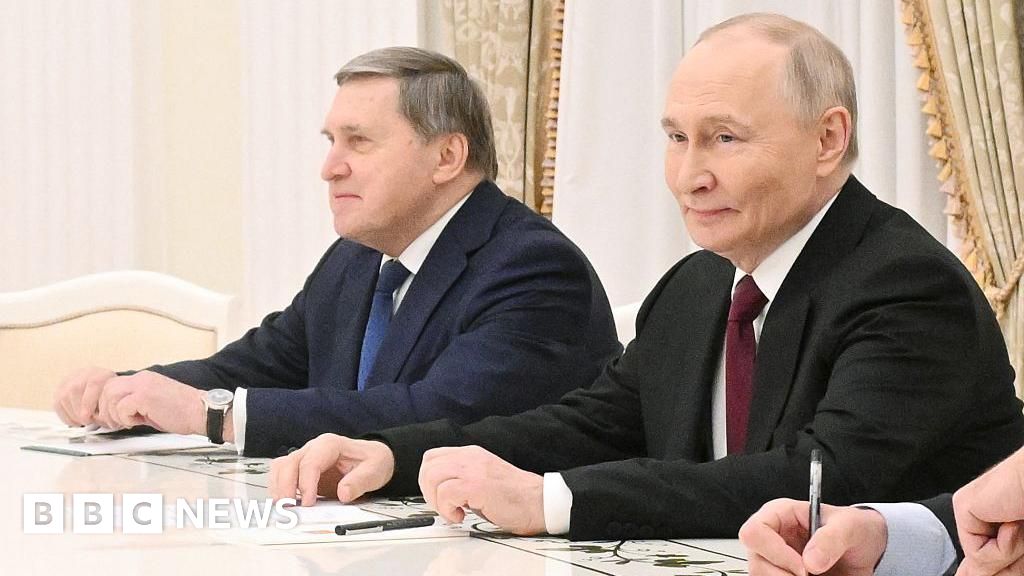Kremlin signals no breakthrough after Ukraine talks with US
Five hours of talks between Russian President Vladimir Putin and US President Donald Trump’s senior negotiator appear to have failed to produce a breakthrough on securing a Ukraine peace deal.
A Kremlin spokesman said the Moscow meeting was “constructive”, but parts of the plan remained unacceptable to Russia.
Trump’s special envoy Steve Witkoff and son-in-law Jared Kushner attended the talks after weeks of intensive diplomacy aimed at ending the war. The US team has not commented since leaving Moscow.
Earlier on Tuesday, Putin said changes proposed by Kyiv and Europe to a US-backed draft peace plan were unacceptable, adding if Europe “wants to go to war and starts one, we are ready right now”.
Ukraine and its allies have been lobbying the US to amend its draft peace deal, which the White House has sought to secure rapid agreement on and the Kremlin has previously indicated it was receptive to.
That plan, which was widely seen as being favourable to Russia after being leaked to the media in November, has undergone several changes in recent weeks.
Asked about the proposal after the Moscow meeting, Putin’s senior aide Yuri Ushakov said the Kremlin “agreed with some points… but some things we criticised”. He added: “We have not come up with a compromise version yet… A lot of work lies ahead.”
Key disagreements between Moscow and Kyiv remain, including over Ukraine agreeing to cede territory it continues to control and security guarantees provided by Europe.
Moscow and Ukraine’s European allies also remain starkly at odds over their expectations of what a peace settlement should look like.
Speaking ahead of the talks, Putin lashed out at leaders on the continent who have supported Kyiv’s defensive war effort since Russia launched a full-scale invasion in 2022.
He said European leaders were under the illusion they could inflict a strategic defeat on Russia. His country, he said, “wasn’t planning to go to war with Europe – but if Europe suddenly wants to go to war and starts one, we are ready right now”.
Ukrainian President Volodymyr Zelensky said he expected to be briefed on the Kremlin talks by the US team after the meeting, though it was unclear whether Witkoff and Kushner would fly to Kyiv or other European capitals for further in-person negotiations.
Speaking before the Kremlin talks took place, the Ukrainian leader said on Tuesday there was an opportunity to end the war “now more than ever”, but that elements of the proposals still needed to be worked out.
“Everything depends on today’s discussions,” Zelensky told a press conference during an official visit to Ireland.
Zelensky said there were “no simple solutions”, repeating his country’s insistence that Kyiv take part in peace discussions, and that clear security guarantees be agreed, such as Nato membership – a move long opposed by Russia and ruled out by Trump.
“We have to stop the war in such a manner that in one year, Russia would not come back”, Zelensky added.
Ukrainian representatives have held two rounds of high-level talks on the draft plan in recent weeks, which have been attended by Witkoff, Kushner and US Secretary of State Marco Rubio.
The White House said the proposals had been “very much refined” as a result, although details of the updated plan have not been confirmed.
Putin – who believes Russia has the initiative on the battlefield – had appeared immovable on his demands as recently as last week, while Zelensky has repeatedly said he would never relinquish control of eastern Ukrainian regions.
While Tuesday’s talks were under way, Trump told his cabinet in Washington that the conflict had not been easy to resolve, describing the conflict as “a mess”.
Kyiv’s European allies had countered the US-backed 28-point plan with their own document – removing many of the most contentious elements, such as Washington’s recognition of Donetsk and Luhansk as de facto Russian.
Zelensky had met French President Emmanuel Macron on Monday, with several European leaders joining the meeting virtually.
Macron said there was “no finalised plan to speak of” and that it could only be achieved with input from Ukraine and Europe.
Meanwhile, fighting continued on the front lines on Tuesday. Ukraine’s military said it was still engaging Russian troops in the key eastern city of Pokrovsk – contradicting Moscow’s claim to have captured it.
Russia’s Ministry of Defence shared a video on Telegram claiming to show its troops holding up flags in the strategically important city, which they have been trying to seize for over a year.
Ukraine’s eastern military command claimed Russia had tried to “flag-plant” in the city so that “propagandists” could say it had been captured. “They fled in a hurry, and the mopping up of enemy groups continues,” it said in a statement on social media.
Ukraine’s military said its forces still controlled the northern part of the city, with Russian units suffering heavy losses, while international observers also disputed Russia’s claim to the area.
The military in Kyiv also dismissed Russia’s claims to have captured the north-eastern Ukrainian border town of Vovchansk and said it had “significantly improved” its position in the northeastern city of Kupyans, which Russia claimed to have conquered a fortnight ago.
Since Russia invaded Ukraine on 24 February 2022, tens of thousands of soldiers have been killed or injured – alongside more than 14,000 civilians, according to the UN.
Civilian targets including kindergartens, hospitals and residential buildings have been destroyed or heavily damaged by nightly drone or missile attacks.
The conflict between the two ex-Soviet states stretches back to 2014 when Ukraine’s pro-Russian president was overthrown and Russia responded by annexing Crimea and supporting armed uprisings in eastern Ukraine.
